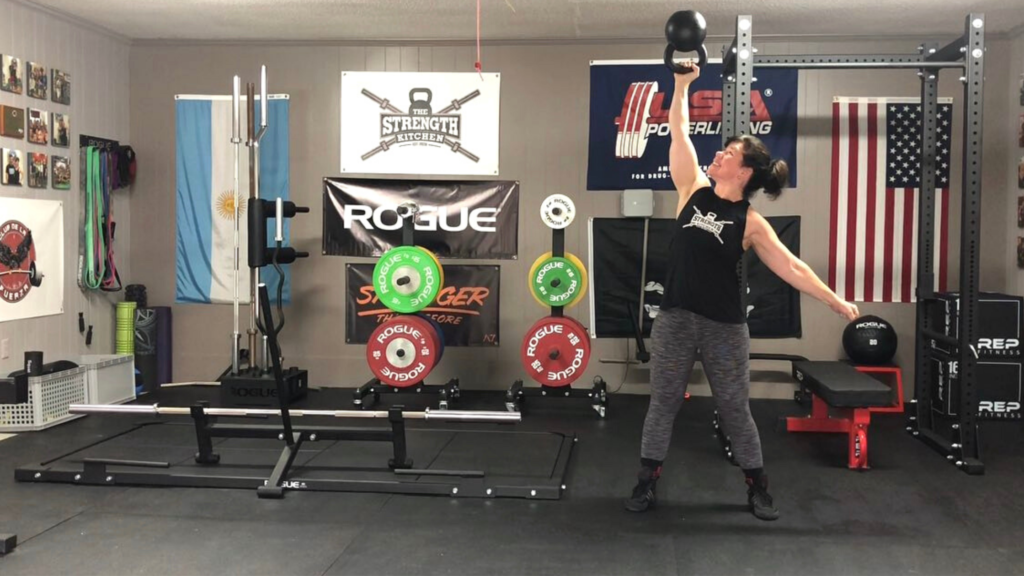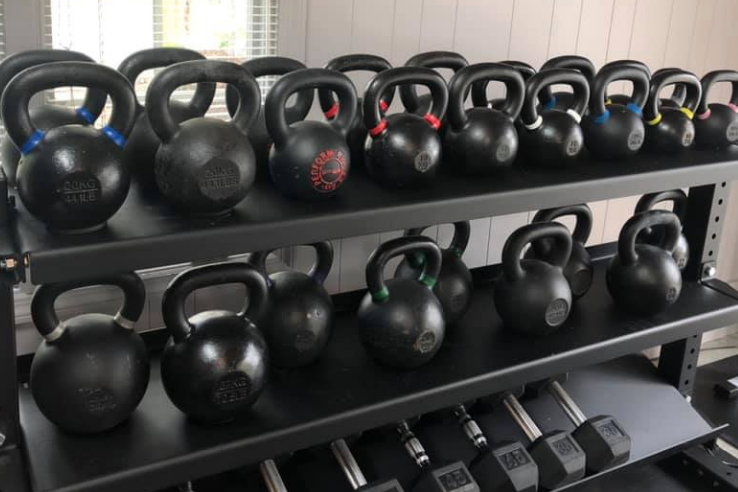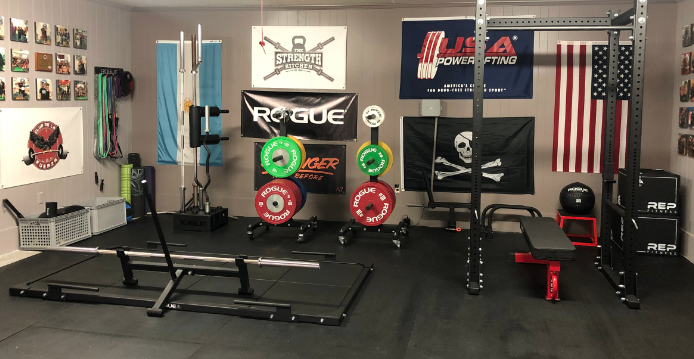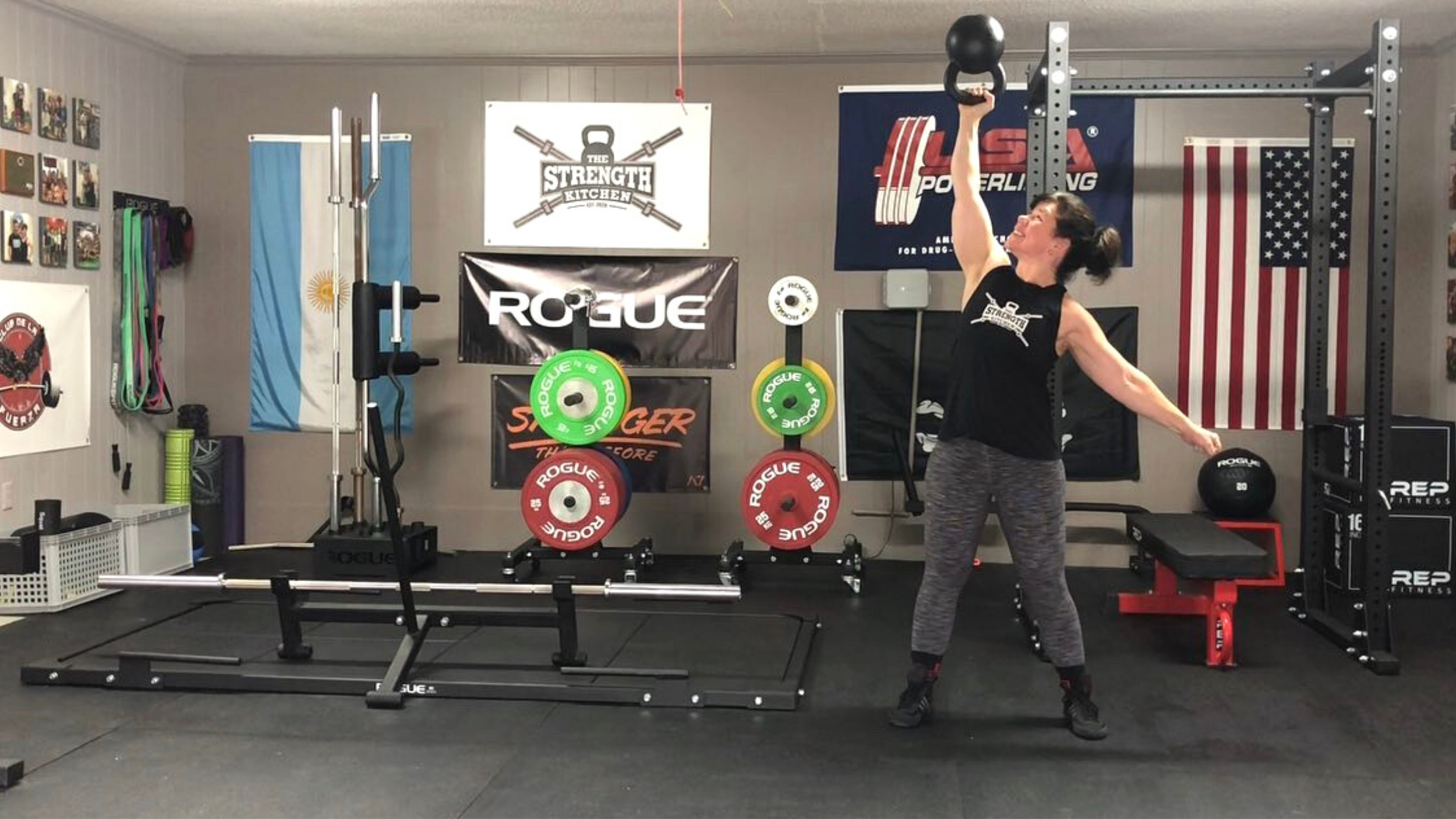
Tracy Cook in the “Strength Kitchen” – Savannah, GA
If there is one clear winner from 2020 – it’s the home gym market.
In fact, dumbbells and kettlebells seem only just behind toilet paper and hand sanitizer in terms of consumer demand.
As a kettlebell lifter, I’ve been a fan of working out at home for years.
While I love to bro-out up and down aisles of machines in commercial gyms, I also know how to get a world-class workout with just my own body and a few simple tools.
But training at home isn’t just for fitness fanatics like me.
I recommend a basic home gym setup for all my clients.
Even before the pandemic, going to the gym was a hassle… Traffic, jockeying for equipment, rushing for work or dinner, taking weird looks as you do your mobility routine…
They can all add up to major roadblocks to your success.
Your progress hinges on consistency and that means reducing barriers as much as possible.
Having the option to workout in the comfort of your own home, on your own schedule, is an obvious asset for anyone prioritizing fitness in their life.
Your home gym could range from a simple “courage corner” of a mat and a few kettlebells, to a fully stocked 2-car garage with racks and barbells, and anything in between.
I’ve been helping clients all year to outfit their homes with the right gear for their needs and budget and I’d like to do the same for you here.
What follows is a not-so-short list of at-home workout equipment I use personally and recommend to clients. I’ve included some context on the benefits of each piece so you can make an informed buying decision.
* Assume that every link is an affiliate link, meaning I’ll receive some amount of commission on sales.
Kettlebells

Surprise! 😉
Seriously, nothing beats a kettlebell or two for getting a stellar minimalist workout. If you want one small, nearly indestructible tool to cover most of your strength, cardio, and mobility needs, look no further.
I’ve written an entire kettlebell buyer’s guide, but here’s the gist:
Men start with 12, 16, and 24 kgs. Women start with 8, 12, and 16 kgs. If you have to pick just one, get the middle weight.
I recommend DragonDoor and Rogue kettlebells.
Resistance Bands
Bands super portable, weigh almost nothing, and have a wide range of uses.
Band pull-aparts and dislocates are staples for shoulder mobility and rotator cuff strength. Loop under your feet for bicep curls and over a bar for tricep extensions. The x-band walk and banded RDLs are my favorite lower body drills and heavier bands are useful for assisted pull-ups.
A set of Orange, Red, and Blue from Rogue should cover most of your needs.
Pec Stick
The most recent addition to my home training arsenal is the decidedly old-school pec stick.
It’s a simple design of a heavy duty spring with handles on either side. You bend it and… that’s really it.
Sure, the pec stick is a one-trick pony, but it’s a pretty good trick.
Pectoral work isn’t just important for aesthetics or muscle growth- the pecs play an important role in shoulder health and all pressing exercises.
The pecs are notoriously difficult to isolate – even in exercises like push-ups and dumbbell flys, the delts and traps often take over. The stick all but forces pec activation without the need for weights or even special cueing and coaching.
The isometric nature of the stick squeeze can also be used to amp up core engagement in other simple exercises like squats and dead bugs.
Dumbbells
Dumbbells are obviously a great addition to a home gym. They are beginner-friendly and just about everybody knows a few basic lifts.
While a full set could easily include 20 or more dumbbells (pairs of 5 through 50 lbs), you’ll get the most use out of a light pair (for arm/shoulder work), a moderate bell (for rows and presses), and a heavy pair (for squats and RDLs).
This might translate to a pair of 10 – 20 lbs, a 35 lb, and a pair of 50 lbs.
Pull-up Bar
There’s really no substitute for pull-up bar work. Even if pull-ups aren’t in your wheelhouse, bar hangs, scap pulls, leg raises and various other drills are great for shoulder health and back and core strength.
Door jam pull-up bars might seem dicey at first, but I’ve never had or seen a problem with them. Just be sure the fit is secure and consider wrapping a hand towel around the arms to minimize scuffing up your door frame.
Ab Wheel
Here’s another one-trick-pony that’s more than worth the investment.
The ab wheel rollout is one of the best core exercises you can do and is scalable to every fitness level.
> Ab Wheel
TRX/Rings
A suspension trainer or a pair of rings is the perfect compliment to your pull-up bar. Just loop them over the bar and you’re ready to go.
The bodyweight row is the most valuable exercise these afford, but TYIs, dip lockouts, and ring push-ups are fun as well.
> TRX
> Rings
Mini Bands
When worn around the thighs, ankles, or feet, mini bands will help target the glutes during lower body moves like squats and lateral walks. These make for effective activation/warm-up drills and really intensify weighted squats.
Mark Bell’s Hip Circle is the most comfortable option for this lower body work and is my top recommendation for powerlifters and heavy squatters.
Much like their full-length brothers, mini bands are great for training the rotator cuffs with various pressing and pull-apart drills.
Barbells & Plates
If absolute strength is your goal, the barbell is your weapon of choice.
Of course, you’ll need a rack and bench to maximize the use of a barbell, but deadlifts, rows, cleans and presses are big money lifts that require no extra gear.
Unless you have a deadlift platform or are a strength athlete, opt for bumper plates. Trap or Hex bar deadlifts tend to be easier on the back making them a good choice for new lifters, young athletes, or those with cranky low backs.

Parallettes
Parallettes aren’t just for gymnastic feats of strength. The basic parallel bar dip lockout and L-sit or tuck holds are excellent arm and core exercises for the intermediate lifter. They can be used as stands for low incline push-ups.
Here’s how you can build your own for cheap:
Jump Rope
Skipping rope is the ultimate low-tech choice for athletic conditioning. The cardio endurance benefits are obvious, but you’ll also build resilient feet and calves alongside body rhythm and coordination.
Grippers
Grip and forearm strength is an often overlooked component of performance. Closing a spring-loaded gripper is a safe (no weight lifting required) and guaranteed way to boost grip strength.
Like the pec stick, a gripper can also be used to amp up other exercises.
Sandbags
Sandbags can be used to load up nearly any lift. Because there’s no dedicated handle, you have to wrestle to hold, hug, lift, and carry the bag any way you can. This is “odd object” training and is a fun way to add a touch of “real life” functionality to your lifts.
Myofascial Release
Various self-massage tools are handy for warm-ups, cool-downs, and mobility work.
While the science is still iffy on how much they actually help with recovery, it feels great to roll out and that’s good enough for me.
The list could go way, way on.
Start small with the gear you know and remember…
Any piece of equipment is worth the investment if you actually use it.
